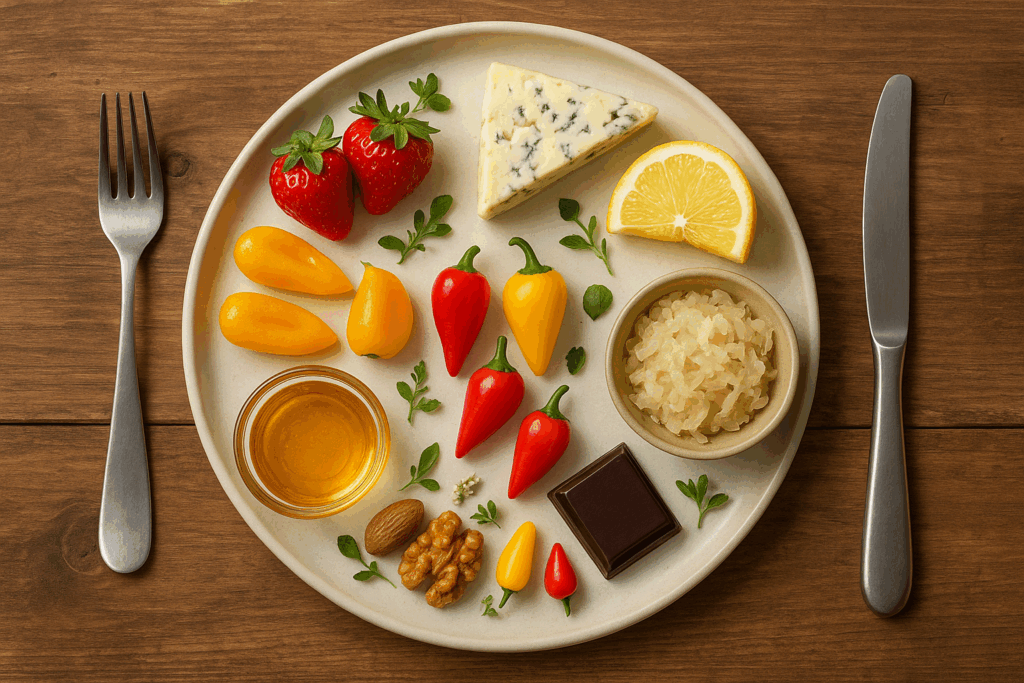The human palate is a true marvel. With just five basic tastes – sweet, sour, salty, bitter, and umami – an infinite variety of culinary experiences emerges. But only through the right combinations does a true explosion of flavor unfold. It becomes especially exciting when contrasts meet: sweet and sour, or spicy and savory. A perfect example of this is the delightful Sweety Drops – small, sweet-sour-spicy peppers that elevate any dish and take the palate on a journey of flavors. But what exactly lies behind these five tastes?
Sweet – The Temptation of the Palate
Sweet foods have always awakened our childlike joy and are closely tied to feelings of happiness. This taste signals energy in the form of sugar and instinctively makes us crave more. Ripe fruits, honey, chocolate, or caramelized onions deliver this pleasant temptation. Things get especially interesting when sweetness is combined with an unexpected note – such as a hint of acidity or a touch of spice.
Sour – The Refreshing Wake-Up Call
Sourness is a wake-up call for our senses. It brings freshness, lightness, and a dynamic twist to many dishes. Think of a splash of lemon juice on a fresh oyster or the delicate tang of good vinegar in a vinaigrette. Fermented foods like sauerkraut or kimchi also shine with their layered acidity. When combined with sweet or spicy flavors, sourness creates a harmonious interplay that brings dishes to life.
Salty – The Spice of Life
Salt is more than just a seasoning – it’s a flavor enhancer, a taste booster that allows flavors to fully unfold. A dish without salt often tastes bland, as salt brings out nuances and creates a well-balanced overall profile. Whether it’s a crispy salt crust on bread, a pinch of fleur de sel over chocolate, or the savory punch of aged cheese – salt is everywhere. The magic happens when it meets sweet or sour components, like in caramelized nuts or fruity combinations.
Bitter – The Elegant Depth
Bitter is perhaps the most sophisticated taste. While many initially perceive bitterness as unpleasant, over time it can be deeply appreciated for its complexity. Espresso, dark chocolate, chicory, or grapefruit are classic bitter notes. In fine cuisine, bitterness is often deliberately used to create depth and tension. A compelling example is the pairing of bitterness and sweetness – like a crisp arugula salad with fruity accents, forming an intriguing composition of flavors.
Umami – The Savory Satisfaction
Umami is the elusive yet deeply satisfying fifth taste. Often described as „savory“ or „rich,“ it adds a special depth to dishes. Umami is found in fermented products like soy sauce, Parmesan, mushrooms, or tomatoes. It becomes especially intense when combined with the other tastes. Anyone who has tried creamy, umami-rich cheese with a hint of sweetness knows how harmonious and exciting this flavor can be.
The Magic of Perfect Pairings
Each individual taste is fascinating – but true culinary magic happens when they come together. Sweet and salty, sour and umami, bitter and sweet – the interplay of flavors is endless. Particularly enticing is the combination of sweet, sour, and spicy, as found in the unique Sweety Drops. These tiny peppers unite the sweetness of ripe fruit with a refreshing acidity and a gentle, subtle heat. Whether as a topping for salads, an elegant companion to cheese, or an exciting element in exotic dishes – they are a true highlight for the palate.
Taste is more than just a sensory impression – it’s a journey. And those who embrace the art of combination will be rewarded with unforgettable flavor experiences.
